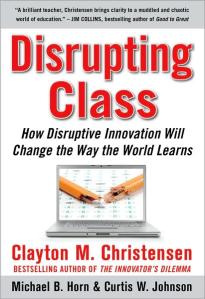The first summer read I picked up was Disrupting Class by Clayton M. Christensen.
[caption id="attachment_356" align="aligncenter" width="205" caption="Disrupting Class by Christensen"] [/caption]
[/caption]
Here are some of my favorite "sticky note" ideas from the book (pages I just had to put a sticky note on - a strategy my students use to share their favorite parts of books during the school year):
Great read, energizing and vindicating!
[caption id="attachment_356" align="aligncenter" width="205" caption="Disrupting Class by Christensen"]
 [/caption]
[/caption]Here are some of my favorite "sticky note" ideas from the book (pages I just had to put a sticky note on - a strategy my students use to share their favorite parts of books during the school year):
- "Motivation is the catalyzing ingredient for every successful innovation. The same is true for learning." p. 7
- "The students who succeed in schools do so largely because their intelligence happens to match the dominant paradigm in use in a particular classroom - or somehow they have found ways to adapt to it." p. 35
- How might schools start down the path toward "student-centric classrooms? Computer-based learning! "Student-centric learning opens the door for students to learn in ways that match their intelligence types in the places and at the paces the prefer by combining content in customized sequences." p. 38
- "Larry Cuban...reports that in early-grade elementary school classrooms, computers serve to sustain the traditional early childhood school model. Computers have become just another activity center for children that they can opt to use in the course of the day." He then goes on to talk about the popular drill and practice games that are often played during this computer time commenting that, "As such, computers add cost while failing to revolutionize the classroom experience." pgs. 81/82
- Interesting view, although I'm not sure I agree: "Because student-centric technology allows for far more personalized attention from a teacher, we can do something counterintuitive in education - increase the number of students per live teacher. Facilitatating this disruption of instruction has the potential to break the expensive trade-offs in which school districts have been trapped so that individual teachers can do a better job and give individual attention to more students. As a result, there potentially will be more funds to pay teachers better." p. 107
- In discussing how the age of high-stakes assessment (like the evolution of inspection in industry) has changed a teacher's job, Christensen states that "...at least 80% of the typical teacher's time is now spent in monolithic activity - preparing to teach, actually teaching, and testing an entire class. Far less than 20% is available to help students individually." However when we teach through student-centric online technology, whole group, end of unit exams are not necessary. "...assessment and individualized assistance can be interactively and interdependently woven into the content-delivery stage, rather than tacked on as a test at then end of the process." p. 111
- After mentioning how powerful teachers unions and textbook companies often squash school reform efforts, Christensen states, "...when disruptive innovators begin forming user networks through which professionals and amateurs - students, parents, and teachers - circumvent the existing value chain and instead market their products directly to each other... the balance of power in education will shift." p. 142
Great read, energizing and vindicating!






